Abstract
Objectives
To assess submental route intubation as an alternative technique to a tracheostomy in the management of the airway in cranio-maxillofacial trauma, along with an assessment of its morbidity and complications.
Materials and Methods
Submental intubation was performed in 17 patients who had maxillofacial panfacial trauma and management was done under general anesthesia during a period of one year from 2013 to 2014 at Departments of Oral and Maxillofacial Surgery and Dentistry, the Malankara Orthodox Syrian Church Medical College, Kochi, India.
Early reconstruction by open reduction and rigid internal fixation has become the standard of care in the management of panfacial fractures1. Airway reconstruction and maintenance should be given equal importance during surgery. However, in cases of panfacial fracture, surgeons and anesthesiologists essentially compete for the same space. Surgeons require an unobstructed view for reconstruction and maxillo-mandibular fixation, if needed23. In such cases, oral intubation cannot be performed, as it may interfere with maxillomandibular fixation. Previously, in situations where oral and nasal intubation are contraindicated, a cricothyrotomy or tracheostomy has been used for airway maintenance4.
In 1986, Hernández Altemir5 introduced the submental route for intubation as an alternative technique for airway management in cranio-maxillofacial trauma. In this technique, a tube is passed through the anterior floor of the mouth in order to allow free intraoperative access to the oral cavity and nasal pyramid without compromising the airway in patients with skull base trauma. Submental intubation can be used for short-term airway control as an alternative to tracheostomy, but with minimal complications67.
The purpose of this study was to investigate outcomes of submental intubation in a series of patients who underwent surgical intervention for management of panfacial trauma.
This was a prospective clinical study conducted at the Department of Oral and Maxillofacial Surgery, Malankara Orthodox Syrian Church Medical College (Kochi, India) between October 2013 and March 2014, after obtaining clearance from the Institutional Ethics Committee (No. MOSCMC/IEC/2013/08). Seventeen patients who presented with maxillofacial trauma and for whom oral and nasal intubation was contraindicated were selected for this study. Patients with multi-organ trauma and patients requiring long-term airway support were excluded from this study.
All subjects underwent orotracheal intubation by standard direct laryngoscopy after induction of general anesthesia with a reinforced cuffed flexo-metallic tube. Orotracheal intubation was then converted to submental endotracheal intubation using the following procedure. Briefly, the skin of the perioral and submental regions was prepared using betadine and alcohol. A transverse 1-cm incision was made, bisecting the midline of the face in the submental crease below the lower border of the mandible.(Fig. 1, 2) The mouth was opened, and the tongue was elevated in a superoposterior direction with a towel clip. A 1-cm midline mucosal incision was made midway between the point of reflection of the mucosa from the mandible to the floor of the mouth and the submandibular ductal papillae.(Fig. 3) The incision was then deepened inferiorly between the geniohyoid, genioglossus, and the anterior bellies of the digastric muscles. A large curved hemostat was placed through the submental incision, and the pilot tube connector was grasped and pulled through the incision.(Fig. 4, 5) The connector on the endotracheal tube was removed and then exteriorized via the submental incision. After confirmation of its adequate tracheal position by capnography and bilateral auscultation of the lungs, the tube was reconnected and secured to the skin with 1-0 silk sutures.(Fig. 6) The tube was positioned intraorally between the mandible and the tongue just above the mucosa of the floor of the mouth.
After submental intubation was complete, anatomical reduction and reconstruction using rigid internal fixation were performed using miniplate osteosynthesis. At the end of the surgical procedure, the connector was removed. The pilot tube and the endotracheal tube were passed back through the incision into the mouth, reversing the original path. The submental wound was sutured using 3-0 silk sutures. None of the patients required postoperative ventilation. Patients were reviewed at 1 week and 1 month.
Demographic and patient clinical data are shown in Table 1. The submental intubation procedure itself did not cause any complications. In all patients, submental intubation helped to synchronize treatment of fractures without any interference from tubes. There was no need to change the method of intubation during surgery for fracture management.
The total duration of the submental intubation procedure ranged from 5 to 8 minutes, with a mean of 6 minutes. No difficulty was encountered when the tube was passed through the floor of the mouth. Disconnection and reconnection from the standard intubation to the submental intubation were performed with ease; no complicating incidents, such as accidental extubation, exposure of the wires, or loosening of the connector after reattachment, were recorded during this procedure. The period of disconnection from the ventilator ranged from 1 to 3 minutes, with a mean of 1.9 minutes. None of the patients showed any significant oxygen desaturation during the procedure. All patients were extubated in the immediate postoperative period, and none required prolonged ventilation.
In the postoperative review period, three patients developed hypertrophic scars, one patient developed orocutaneous fistula, and one patient developed mucocele.(Fig. 7) All of these complications were managed using conventional methods. There were no motor or sensory deficits recorded in any patients.
Injuries to the head and maxillofacial areas can easily jeopardize the ability to maintain the airway, and attention should first be directed to a secure airway. The development of equipment and techniques for endotracheal tube placement started after inadvertent awake placement of a tube into the trachea by Persian surgeon Desault8. Airway management for anesthetic purposes was conceived in 1871 by the famous German surgeon Trendelenberg, who adopted a method of delivering chloroform into a tracheostomy tube for human use9.
Endotracheal intubation in patients with maxillofacial trauma is challenging for both anesthesiologists and surgeons and requires good communication between them. Surgeons operating on panfacial injuries in patients with nasal or oral endotracheal intubations may interfere with the endotracheal tube while operating, which can be a potential source of infection. Nasotracheal intubation may also cause complications such as cranial intubation, epistaxis, trauma to the pharynx, pressure necrosis of the external nares, otitis media, sinusitis, sepsis, and inability to pass a tube through nasal passages101112. Nasotracheal intubation is often difficult due to deviation of the nasal septum and hypertrophy of nasal turbinates, and it can result in transfer of infection from the nose to the bronchial tree1314.
Cases of panfacial trauma occasionally call for an alternative to oral and nasal endotracheal intubation. The standard route of access has been with a tracheostomy approach for this subpopulation. However, tracheostomy can cause general, local, early, and late complications including cardiac arrest caused by stimulation of vagus nerve, post hypercapnic shock due to sudden lowering of carbon dioxide level, and aeroembolism15. Other complications include hemorrhage, subcutaneous or mediastinal emphysema and recurrent laryngeal or tracheal stricture, hemorrhage from large blood vessels caused by decubitus of vessel walls, trachea-esophageal fistula, extensive granulation, and inflammatory complications16. Cricothyroidotomy may be a useful alternative to establish an emergency airway in adult patients; however, as it is associated with significant complications, it cannot be used when prolonged ventilation is required. Additionally, cricothyroidotomy is associated with both major (death, subglottic stenosis, subglottic granulation tracheomalacia) and minor (transient hoarseness, aspiration pneumonia, pain at stoma scar, stoma site bleeding, stoma site abscess, subglottic ulceration) complications, which limits its use17.
There have been several attempts to achieve short-term airway maintenance in the literature. A simple technique of retromolar intubation was described by Martinez-Lage et al.18 and carries the advantage of no interference with occlusion in craniofacial, orthognathic, oncologic, and trauma surgery procedures. However, it has many disadvantages, including increased patient trauma, obstructive to the operative field, and long operative time.
Another alternative, the nasal tube switch technique, in which the endotracheal tube is intraoperatively shifted from the oral to nasal route, is described by González-Garcia et al.19. It carries disadvantages including risk of aspiration due to posterior nasal bleeding and potential airway compromise with need for emergency tracheostomy or cricothyroidotomy. The floor of the mouth and submental region are attractive alternative choices. Hence, attempts have been made to maintain the endotracheal tube in the midline or paramedian region. These two variations have become the techniques of choice to obtain restoration of traumatized soft tissues and bone fragments in proper approximation depending on laceration of the soft tissues and the bony architecture involved.
Endotracheal intubation with a submental route was first described by Hernández Altemir5 in 1986. This technique provides a secure airway, an unobstructed intra-oral surgical field, and allows maxillo-mandibular fixation, thereby avoiding the drawbacks and complications of oral and nasal intubation, as well as tracheostomy. This technique is also referred to in the literature as sub-mandibular intubation by Anwer et al.20 or as transmylohyoid intubation by Adeyemo et al.21. Despite the widespread use of submental intubation for other purposes, Bögi and Incze22 in 1996 recommended the use of submental intubation by a paramedian approach.
In our study, 17 patients were intubated through a submental route. The technique was found to be simple and reliable. Hypertrophic scar was found in three cases (17.6%), orocutaneous fistula in one case (5.9%), and mucocele in one case (5.9%). All postoperative complications were effectively managed. Various other complications described in the literature (e.g., trauma to the submandibular and sublingual glands or ducts, damage to the lingual and marginal mandibular nerve2324) were not experienced in our study. The findings of this study concur with the findings of Nayan et al.25 that submental intubation provides a better field of work for the oral and maxillofacial surgeon, avoids complications, and allows intraoperative maxillo-mandibular fixation in patients with nasoethmoidal complex fractures along with associated maxilla mandibular fractures without having to resort to tracheotomy.
Over time, several modifications to this procedure have been introduced. One modification introduced by Gadre and Waknis involves passage of the endotracheal tube anywhere through the mylohyoid muscle26. Another modification involves the use of two endotracheal tubes for intubation, referred to as anterograde and retrograde approaches27; this technique is believed to be superior because of the decreased chance of hypoxia. Nyárády et al.28 have suggested the "rule of 2-2-2", which describes a 2-cm-long incision, 2 cm from the midline and 2 cm medial and parallel to the mandibular margin for placement of the endotracheal tube. Mahmood and Lello29 have performed submental intubation using a preformed Sheridan tube, which has a preformed curvature that helps in positioning by conforming to the anatomy of the region. Lima et al.30 have utilized a surgical gloved finger and Adeyemo et al.21 have used a nylon tube sac to cover the proximal end of the endotracheal tube, which helps prevent entry of blood and soft tissue during its passage through the orocutaneous tunnel.
The submental route for endotracheal intubation is a simple and reliable method for short-term maintenance of airways in panfacial trauma patients because the endotracheal tube does not interfere with occlusion during fracture reduction and fixation and has minimal or negligible postoperative complications.
References
1. Shetty PM, Yadav SK, Upadya M. Submental intubation in patients with panfacial fractures: a prospective study. Indian J Anaesth. 2011; 55:299–304. PMID: 21808409.

2. Markowitz BL, Manson PN. Panfacial fractures: organization of treatment. Clin Plast Surg. 1989; 16:105–114. PMID: 2924486.

3. Shumrick KA, Kersten RC, Kulwin DR, Sinha PK, Smith TL. Extended access/internal approaches for the management of facial trauma. Arch Otolaryngol Head Neck Surg. 1992; 118:1105–1112. PMID: 1389061.

4. Phero JC, Weaver JM, Peskin RM. Anesthesia for maxillofacial/mandibular trauma. Anesthesiol Clin North Am. 1993; 11:509–523.

5. Hernández Altemir F. The submental route for endotracheal intubation. A new technique. J Maxillofac Surg. 1986; 14:64–65. PMID: 3456416.
6. Castling B, Telfer M, Avery BS. Complications of tracheostomy in major head and neck cancer surgery; a retrospective study of 60 consecutive cases. Br J Oral Maxillofac Surg. 1994; 32:3–5. PMID: 8136336.

7. Halfpenny W, McGurk M. Analysis of tracheostomy-associated morbidity after operations for head and neck cancer. Br J Oral Maxillofac Surg. 2000; 38:509–512. PMID: 11010784.

8. Alberti PW. Tracheotomy versus intubation. A 19th century controversy. Ann Otol Rhinol Laryngol. 1984; 93:333–337. PMID: 6380376.
9. Muhsin WW, Rendell-Baker L. The principles of thoracic anaesthesia, past and present. Oxford: Blackwell Scientific Publications;1953. p. 44.
10. Coe TR, Human M. The peri-operative complications of nasal intubation: a comparison of nostril side. Anaesthesia. 2001; 56:447–450. PMID: 11350331.

11. Sanuki T, Hirokane M, Kotani J. Epistaxis during nasotracheal intubation: a comparison of nostril sides. J Oral Maxillofac Surg. 2010; 68:618–621. PMID: 19931965.

12. Seltzer AP. Complications of nasotracheal intubation. J Natl Med Assoc. 1969; 61:415–416. PMID: 5346059.
13. Chandu A, Gibson NS, Smith AC. An unusual complication of naso-tracheal intubation. Int J Oral Maxillofac Surg. 2000; 29:395. PMID: 11071248.

14. Choudhuri AH, Bhatnagar S, Mishra S. Epistaxis after nasotracheal intubation in oral cancer surgeries: a comparison between fibreoptic intubation and conventional technique. Indian J Anaesth. 2006; 50:275–278.
15. Amygdalou A, Dimopoulos G, Moukas M, Katsanos C, Katagi A, Mandragos C, et al. Immediate post-operative effects of tracheotomy on respiratory function during mechanical ventilation. Crit Care. 2004; 8:R243–R247. PMID: 15312224.
16. Mort TC. Emergency tracheal intubation: complications associated with repeated laryngoscopic attempts. Anesth Analg. 2004; 99:607–613. PMID: 15271750.

17. Sise MJ, Shackford SR, Cruickshank JC, Murphy G, Fridlund PH. Cricothyroidotomy for long-term tracheal access. A prospective analysis of morbidity and mortality in 76 patients. Ann Surg. 1984; 200:13–17. PMID: 6732322.
18. Martinez-Lage JL, Eslava JM, Cebrecos AI, Marcos O. Retromolar intubation. J Oral Maxillofac Surg. 1998; 56:302–305. PMID: 9496840.

19. González-Garcia R, Rodríguez-Campo FJ, Naval-Gías L, Sastre-Pérez J. Oral to nasal endotracheal tube exchange following reconstructive surgery of the oral cavity by means of vascularized free flaps. J Oral Maxillofac Surg. 2005; 63:1249–1250. PMID: 16094603.

20. Anwer HM, Zeitoun IM, Shehata EA. Submandibular approach for tracheal intubation in patients with panfacial fractures. Br J Anaesth. 2007; 98:835–840. PMID: 17459905.

21. Adeyemo WL, Ogunlewe MO, Desalu I, Akanmu ON, Ladeinde AL. Submental/transmylohyoid intubation in maxillofacial surgery: report of two cases. Niger J Clin Pract. 2011; 14:98–101. PMID: 21494002.
22. Bögi I, Incze F. Submental introduction of tracheal tube in endotracheal anesthesia. (Modified tracheal intubation method for cases of simultaneous maxillofacial injuries and osteotomies). Fogorv Sz. 1996; 89:3–6. PMID: 8713614.
23. Taglialatela Scafati C. Mucoceles as a complication of submandibular intubation. J Craniomaxillofac Surg. 2004; 32:335. PMID: 15458678.
24. Stranc MF, Skoracki R. A complication of submandibular intubation in a panfacial fracture patient. J Craniomaxillofac Surg. 2001; 29:174–176. PMID: 11465257.

25. Nayan S, Kotrashetti SM, Singh R, Mandlik G, Keswani E, Shevale V. Submental approach for oral endotracheal intubation in maxillofacial trauma: a prospective study. Heal Talk. 2013; 5:26–27.
26. Ramsey CA, Dhaliwal SS. Retrograde and submental intubation. Atlas Oral Maxillofac Surg Clin North Am. 2010; 18:61–68. PMID: 20176327.

27. Green JD, Moore UJ. A modification of sub-mental intubation. Br J Anaesth. 1996; 77:789–791. PMID: 9014636.

28. Nyárády Z, Sári F, Olasz L, Nyárády J. Submental endotracheal intubation in concurrent orthognathic surgery: a technical note. J Craniomaxillofac Surg. 2006; 34:362–365. PMID: 16860564.

29. Mahmood S, Lello GE. Oral endotracheal intubation: median submental (retrogenial) approach. J Oral Maxillofac Surg. 2002; 60:473–474. PMID: 11928115.

30. Lima SM Jr, Asprino L, Moreira RW, de Moraes M. A retrospective analysis of submental intubation in maxillofacial trauma patients. J Oral Maxillofac Surg. 2011; 69:2001–2005. PMID: 21367502.
Fig. 3
Placement of intraoral incision and use of hemostat for creation of continuity through the extraoral incision.
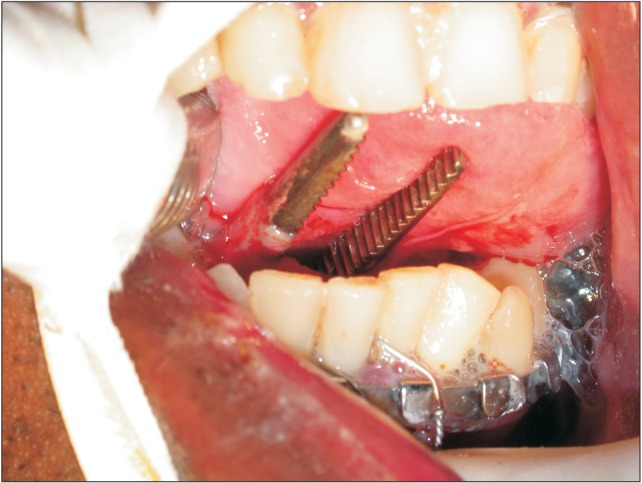
Table 1
Demographic data with complications
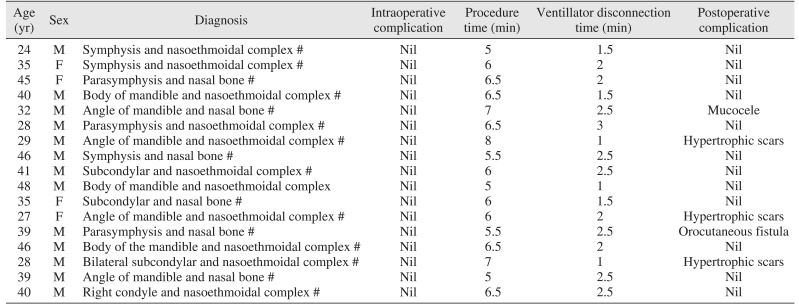




 PDF
PDF ePub
ePub Citation
Citation Print
Print



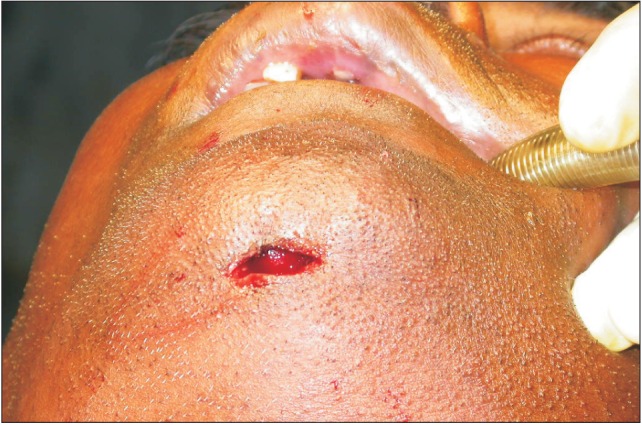
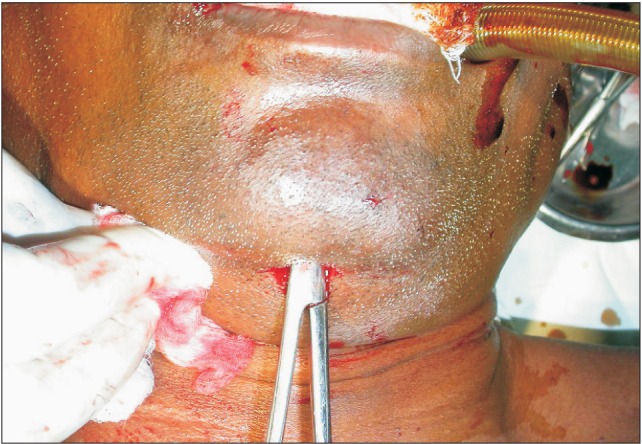
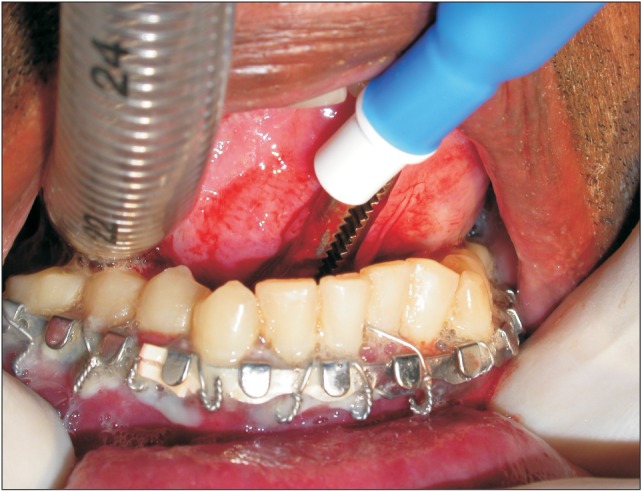

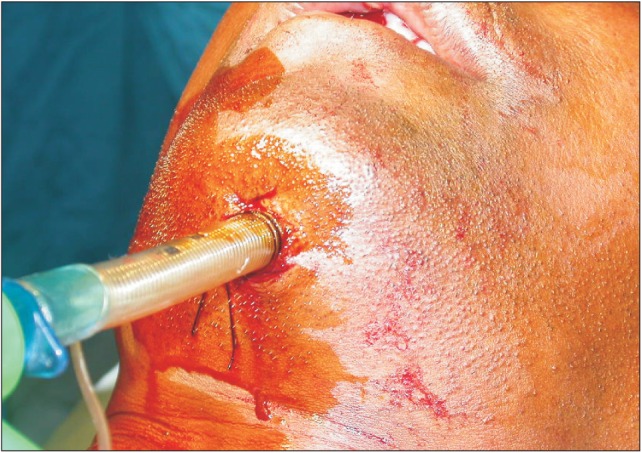
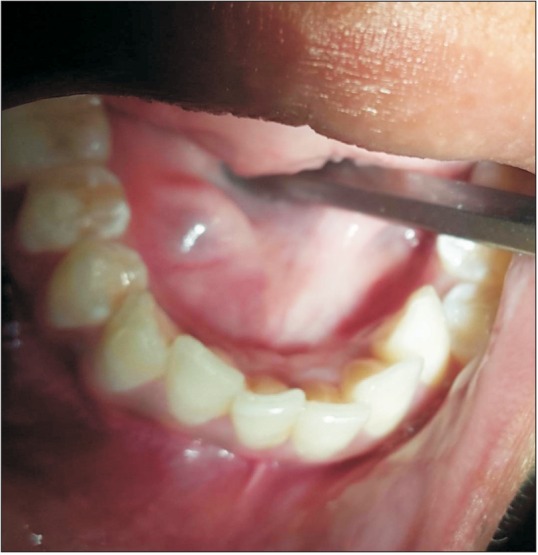
 XML Download
XML Download